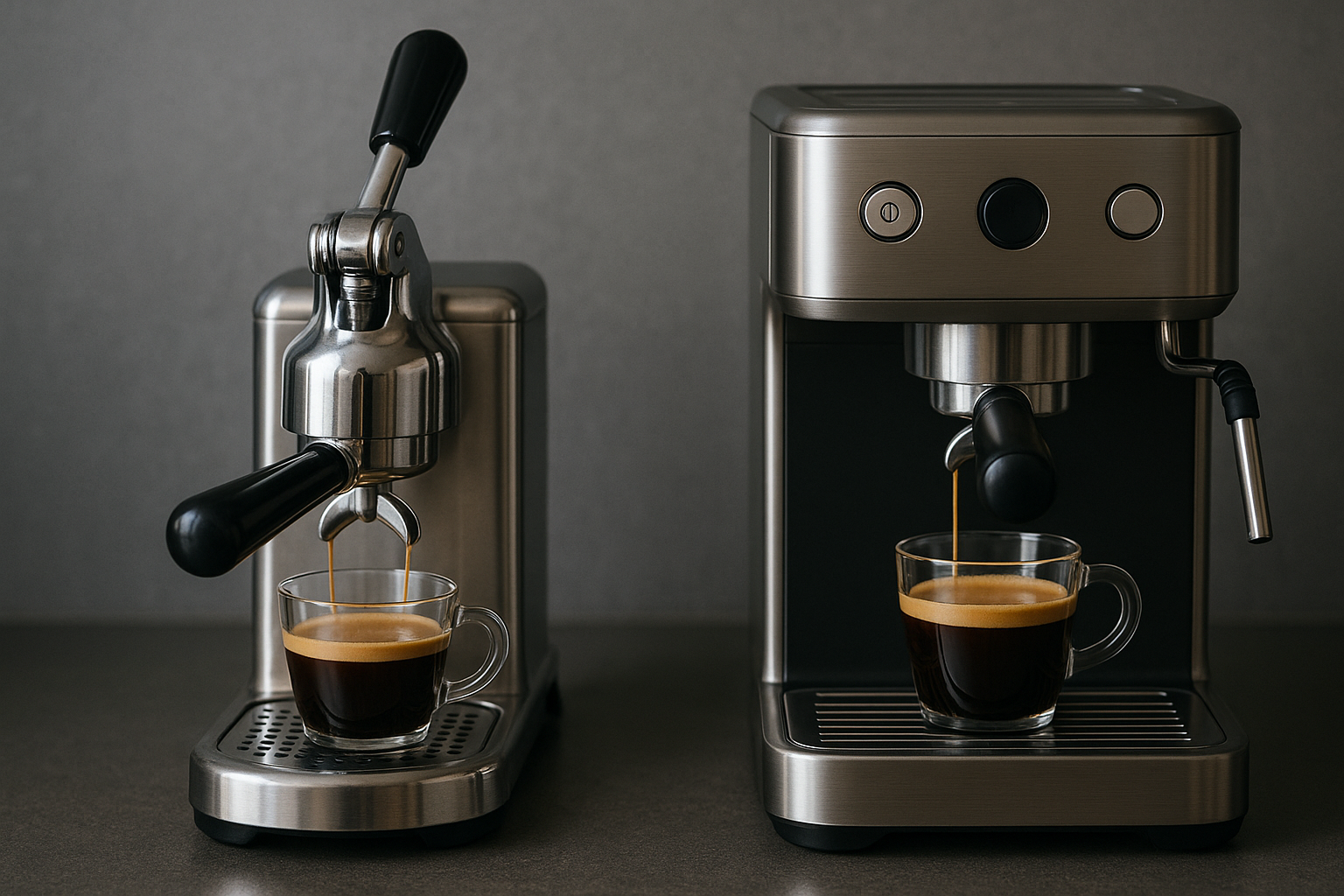Choosing the right espresso machine can be overwhelming — especially when deciding between manual and automatic models.
Whether you’re setting up a home coffee station or running a café, your choice will influence the quality, consistency, and efficiency of your coffee.
This article breaks down the key differences between manual and automatic espresso machines. We’ll explore how each type works, their pros and cons, and which kind of user benefits most from each.
By the end, you’ll know exactly which machine aligns with your goals, skills, and coffee philosophy.
What Is a Manual Espresso Machine?
Manual, or lever espresso machines, are the most traditional brewing devices. As the name implies, they require the barista to physically control water pressure by pulling a lever.
In spring piston models, the user pulls a lever to compress a spring, which then pushes water through the coffee puck. In direct lever models, the user manually controls the entire pressure process.
Manual machines demand skill and precision. Every variable — from pressure and temperature to timing — is in the hands of the barista.
Advantages of Manual Machines
Full Control
Manual machines offer complete control over every step of the extraction process. Skilled users can fine-tune variables to match specific beans or flavor preferences. This allows a high level of customization and experimentation.
Artistic and Satisfying
For coffee purists and professionals, using a manual machine can feel like an art form. The tactile feedback and personal involvement create a deeper connection with the brewing process.
Durability
Manual machines are typically built to last. With fewer electronics and automated parts, they often require less maintenance and have a longer lifespan when properly cared for.
Minimal Electronics
Because they don’t rely heavily on software or automation, manual machines are less prone to tech-related failures. This can be a major plus in environments where electrical reliability is an issue.
Drawbacks of Manual Machines
Steep Learning Curve
Learning to use a manual machine takes time and patience. Beginners may struggle to produce consistent shots, especially under pressure.
Time-Consuming
Manual brewing is slower, which can be a problem in high-volume settings like busy cafés. It also demands constant focus, leaving little room for multitasking.
Physical Effort
Using a manual lever can be physically demanding over time, especially in commercial settings. Repeated use can lead to fatigue or even injury if ergonomics are poor.
What Is an Automatic Espresso Machine?
Automatic espresso machines simplify the brewing process by automating one or more steps. There are three common types:
- Semi-automatic: The user starts and stops the extraction manually, but the machine controls water temperature and pressure.
- Automatic: The machine controls time, pressure, and temperature, delivering consistent shots at the push of a button.
- Super-automatic: These machines grind the beans, tamp the puck, brew the shot, and even steam milk automatically.
Automatic machines are especially popular in commercial settings for their consistency and efficiency.
Advantages of Automatic Machines
Ease of Use
Automatic machines are user-friendly and require less training. This is ideal for beginners, staff turnover situations, or when multiple people are using the same machine.
Speed and Efficiency
Automated processes save time, especially during peak hours. This allows baristas to serve more customers quickly, improving revenue and customer satisfaction.
Consistency
Automatic machines deliver uniform results with every shot. This is crucial in cafés where customers expect the same taste every time.
Built-in Features
Many models come with programmable settings, built-in grinders, milk frothers, and self-cleaning systems. These features simplify operation and maintenance.
Drawbacks of Automatic Machines
Less Control
Automatic machines limit the barista’s ability to fine-tune variables. This can be frustrating for those who want to adjust extraction based on different beans or desired flavor profiles.
Higher Cost
Automatic models, especially super-automatic ones, are often more expensive upfront. Maintenance and repair costs can also be higher due to complex electronic components.
Less Engaging
Some coffee lovers feel disconnected from the brewing process when using an automatic machine. The lack of hands-on involvement may reduce the joy of making coffee for some users.
Risk of Over-Reliance
Relying too heavily on automation can limit a barista’s development. Skills like tamping, pressure control, and milk steaming may go underdeveloped in automated environments.
Manual vs. Automatic: Side-by-Side Comparison
| Feature | Manual Machines | Automatic Machines |
|---|---|---|
| Control Over Extraction | Full control | Limited (varies by type) |
| Skill Level Required | High | Low to moderate |
| Consistency | Depends on user | High (once programmed) |
| Speed | Slower | Faster |
| Cost | Generally lower upfront | Higher, especially for super-automatic |
| Maintenance | Fewer tech issues, more cleaning | Easier cleaning but complex repairs |
| Engagement | Highly engaging | More passive |
| Best For | Enthusiasts, pros, low-volume use | Busy cafés, beginners, multitasking |
Who Should Choose a Manual Espresso Machine?
Manual machines are ideal for:
- Home baristas who enjoy hands-on brewing
- Specialty cafés that prioritize artisanal preparation
- Coffee educators and trainers
- Low-volume operations where speed is not critical
If you’re someone who values craftsmanship and wants to learn the intricacies of espresso, a manual machine offers the freedom to experiment and grow.
Who Should Choose an Automatic Espresso Machine?
Automatic machines suit:
- Busy cafés and restaurants
- Corporate offices and shared workspaces
- Hotel breakfast stations
- Home users who want convenience
These machines reduce human error and ensure consistency, which is vital in commercial settings where speed and reliability matter most.
Hybrid Approaches and New Trends
Some machines blend both worlds. For example, prosumer machines offer manual control with digital features like PID temperature regulation and pressure profiling. These hybrids cater to users who want precision and flexibility without sacrificing ease.
Another emerging trend is app-controlled machines, where users can control brewing variables through a smartphone. These bring more flexibility and personalization to both manual and automatic setups.
Sustainability Considerations
When choosing between manual and automatic machines, consider energy consumption and waste. Automatic machines often have energy-saving modes, while manual ones use less electricity overall.
Some eco-friendly models use recyclable components and are built to last, reducing their environmental footprint. Always research the manufacturer’s commitment to sustainability.
Final Thoughts: Choosing What’s Best for You
There’s no one-size-fits-all answer. Your ideal espresso machine depends on your goals, skill level, and environment.
Choose manual if you:
- Love the ritual and control of coffee-making
- Are willing to learn and invest time in the craft
- Brew for yourself or in a small café with lower volume
Choose automatic if you:
- Need speed and consistency
- Want a simpler, less hands-on experience
- Operate a commercial space with high turnover or volume
Ultimately, the best machine is the one that fits your workflow, inspires your creativity, and delivers the espresso experience you crave.

Artur is a coffee enthusiast and content creator passionate about barista techniques and coffee culture. With a sharp eye for detail and a love for learning, he shares practical tips, brewing guides, and gear insights to help readers elevate their coffee experience — from home brewers to aspiring professionals.
